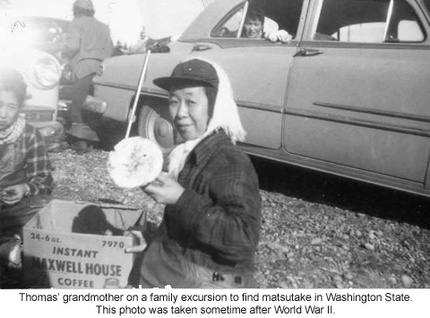A rare, sunny, mildly humid Northwest Labor Day weekend in 2004 arrived shortly after four consecutive days of rain. This was the signal for my father to embark on one of his favorite pastimes—finding the awesome, tasty matsutake mushroom, a small treasure of the Pacific Northwest that is increasingly difficult to find these days.
From his younger days, he learned the secret spots to hit. Although his knee problems made walking quite painful for him,
nothing would keep this very eager Nisei from starting his search. So he invited family out for a matsutake picking adventure at the North base of Mount Rainier, Washington.
Within twenty minutes of a relatively short, but steep hike off the road, he unearthed the beauty of all matsutake mushrooms, the tsubomi*—a bud with a perfectly concentric, white, round shapes. A photo shows him with a big smile as he proudly held up his prize.
We were extremely fortunate that our Grandparents shared their incredible knowledge on how and where to find these little delicacies. When the opportunity to head out for matsutake arrived, we would gather our gear: jackets, hats, rubber boots, along with simple gardening tools such as a weed puller or flathead screwdriver, and finally, a couple of 24-pack soda-can boxes in case we got lucky. Sometimes we came up empty. But on other occasions, we would find colonies!
The best months to look for matsutake are generally late August through early November on partly cloudy or sunny days between rainy periods. We often found them in areas adjacent to small trails in forests off of the highways. Usually a matsutake appears in mossy soil areas under large fir trees. The white buds often are at times partially submerged and barely visible. So you have to walk slowly and observe carefully so as not to miss it. A matsutake mushroom can be distinguished from other species by the aroma as well as the shape and color. Matsutake has a woodsy aroma like a pine tree (matsu). It is firm and its stem is usually a round bud.
Once you have confirmed your find, you can carefully remove it with a gardening tool like a weed remover or a flathead screw driver. After it is removed, you can pat the dirt back up where you found it.
These mushrooms are mixed in with rice when you make matsutake gohan or even a simple dashi soup. They provide the flavor. When you have your prize, wash off the dirt and other elements. Slice them vertically from the bud to the stem into thin strips. If you don’t plan to eat it right away, it might be best to vacuum seal and freeze it until the special occasion arises. For New Year or Thanksgiving gatherings, we would add strips of matsutake with diced green onions or shiso leaves, and slices of kamaboko to make ozoni mixed with mochi in a dashi flavored soup base.
Here is a basic, simple, oishi recipe for matsutake gohan you can tailor with other ingredients that suit your tastes:
2 medium sized (approximately ¾ pound) matsutake mushrooms
2 tablespoons of shoyu
A dash (approximately one teaspoon) of salt
3 cups of riceSlice the mushrooms into small, thin wedges. Prepare the rice in the rice cooker with the appropriate amount of water. Dash the salt and shoyu. Then, spread the mushrooms over the rice. Turn the cooker on. When the times up, mix it all up and spread it into a tray for serving. Sprinkle thin-sliced nori strips if preferred.
While it’s always more fun to explore, and find one for yourself, you can purchase matsutake at Asian markets like Uwajimaya in Seattle during the seasonal months. Enjoy!
Acknowledgements: I would like to thank my Mom for sharing her matsutake stories and cooking techniques.
***
Explanation of the extra Japanese words used in this story:
Dashi – Japanese soup stock
Kamaboko – a type of processed food made from fish
Ozoni - traditional soup served on New Year's Day in Japan
Mochi – a type of food made by pounding rice that has a sticky consistency
Oishi – “delicious”
Gohan – “steamed rice”
Shoyu – “soy sauce”
Nori – “dried seaweed”
* In Japanese, tsubomi is the round “flower bud.” While tsubomi is not used in reference to mushrooms in Japan, many Japanese words have taken on extended meaning by Japanese communities and families living outside of Japan.
***
© 2008 Thomas Tsutsumoto








